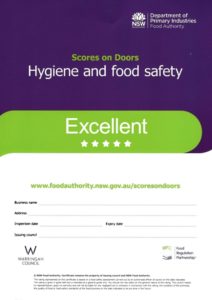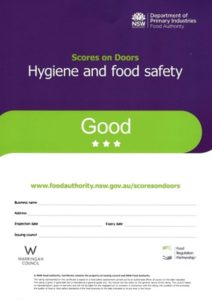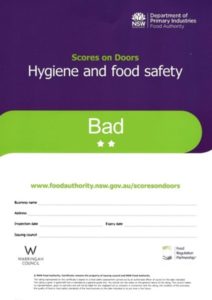“Scores on Doors”: A Non-Mandatory Food Safety Program with Big Impact in NSW, Australia

The Scores on Doors program in New South Wales (NSW), Australia, is a food safety initiative aimed at improving food safety standards in restaurants and other food service establishments by making their hygiene ratings visible to the public.
Officially launched in 2010 as a voluntary initiative in New South Wales, it was initially introduced as a pilot program by the NSW Food Authority in collaboration with local councils. Following its success, it was adopted across the state, with more councils participating over time.
The Scores on Doors program allows consumers to make informed decisions about where to dine by displaying a hygiene rating based on regular inspections.
It has become an effective tool for encouraging food businesses to maintain high safety standards and ensure compliance with food regulations.
At Andy, we believe this initiative is a strong example of food safety transparency, empowering both businesses and consumers to prioritise health and hygiene in the food service industry.
Continue reading to find out more!
Why Was Scores on Doors Introduced to NSW Businesses?
- Rising Concerns about Food Safety: The program was introduced in response to growing public concerns about food safety and hygiene in restaurants and other food establishments. There was increasing awareness about the risks of foodborne illnesses, prompting the NSW government to look for ways to improve hygiene standards in the food service sector.
- Transparent Information for Consumers: Authorities saw the need for a system that allowed consumers to make informed decisions about where they choose to eat based on the hygiene standards of the establishment. By displaying a hygiene rating publicly, food businesses would be held accountable for their food safety practices.
- Improving Compliance: Prior to Scores on Doors, compliance with food safety regulations varied, and there was a lack of a standardised system that could motivate businesses to consistently meet high standards. The program incentivised businesses to maintain better food safety practices to achieve higher ratings.
What at the Goals of the Scores on Doors Program?
- Enhance Public Health: By encouraging better food safety practices, Scores on Doors helps to reduce the risk of foodborne illnesses.
- Drive Accountability: Businesses are more accountable when they know their hygiene standards are being publicly displayed. This creates an incentive to maintain high standards.
- Consumer Confidence: Consumers can feel more confident when dining at establishments that display their hygiene rating, knowing that they have been independently inspected and rated.
- Benchmark for Best Practices: The program sets a benchmark for best practices in food handling and hygiene, driving industry-wide improvements in food safety.
How does the Scores on Doors Program work?
In partnership with local councils, the NSW Food Authority audits and inspects food businesses in NSW at least once a year. A food business may be inspected more than once if complaints have been raised against your food business.
Businesses are rated based on their performance, and the results are presented in the form of a certificate that must be displayed at the front of the premises.
The program uses a simple rating system:
⭐⭐⭐⭐⭐ 5 stars: Excellent food safety and hygiene standards.
⭐⭐⭐⭐4 stars: Very good food safety practices, with minor areas needing attention.
⭐⭐⭐3 stars: Good food safety compliance, with several areas needing correction.
The system suggests the possibility of 2 and 1-star restaurants, indicating below-average performance.
However, anything below 3 stars is considered a failure.
⭐⭐2 stars: Below-average food safety compliance.
⭐1 star: Poor food safety compliance.





Is “Scores on Doors” Compulsory?
Scores on Doors is a voluntary program, meaning it is not compulsory for all food establishments to participate.
However, many local councils across the state of NSW have opted into the program, and food businesses within those areas are encouraged to display their hygiene rating as part of their commitment to food safety standards.
- Participation: Participation in Scores on Doors is not mandated by state law, so businesses are not legally required to display their hygiene scores.
Instead, it is up to individual councils and food businesses to decide if they want to join the program.
However, many local councils actively promote it to raise hygiene standards in their jurisdictions. - Benefits for Businesses: Though optional, many restaurants and food establishments choose to participate because it demonstrates their commitment to food safety, potentially boosting customer confidence and trust.
A high score can be a powerful marketing tool, attracting more customers who prioritise cleanliness and safety.
Motivation for Councils and Businesses
- Council Role: While the NSW Food Authority developed the program, local councils are responsible for carrying out inspections and assigning scores to businesses in their area. Some councils strongly encourage businesses to join as it aligns with their public health objectives.
- Public Pressure: Although participation is voluntary, there can be indirect pressure from the public.
Consumers increasingly expect transparency, and not displaying a rating (or refusing to participate) could raise questions about the establishment’s hygiene practices.
Businesses might feel compelled to join to stay competitive in the market.
Why Not Make it Mandatory?
- Flexibility: The program’s voluntary nature allows flexibility for councils and food businesses, especially smaller or rural businesses that might have resource constraints. Making it compulsory could add additional regulatory burdens, so the choice remains at the local level.
- Variation Among Councils: Not all councils have chosen to adopt Scores on Doors. In areas where it hasn’t been implemented, businesses are under no pressure to participate, though they must still comply with state food safety regulations.
There have been discussions about whether the program should eventually become mandatory, especially given the program’s success and the positive impact it has had on food safety awareness.
Some stakeholders argue that making it compulsory could standardise hygiene transparency across all regions, ensuring that consumers are well-informed no matter where they dine.

What Makes Scores on Doors Effective?
- Clear and Uniform Standards
One of the greatest strengths of the Scores on Doors program is the clear and standardised approach it provides.
The simplicity of the scoring system is built around a uniform checklist used across all councils and food establishments.
This consistency helps standardise expectations for food safety and hygiene.
While some areas of evaluation allow for interpretation—acknowledging that certain issues can vary in severity—this flexibility ensures that inspectors can take a more nuanced, case-by-case approach, addressing the unique circumstances of each establishment.
- Comprehensive Yet Manageable Scope
The program evaluates food businesses based on 45 key criteria, which strikes a perfect balance between being thorough and manageable.
These 45 topics cover a wide range of food safety and hygiene concerns but are not overwhelmingly complex.
This makes it feasible for restaurant owners and operators to review the checklist in advance and take steps to ensure compliance before their inspection.
By focusing on essential elements without burdening businesses with unnecessary complexity, Scores on Doors helps maintain high safety standards without overwhelming small operators.
- Focus on Critical Violations
Scores on Doors places a strong emphasis on critical food safety issues, particularly in areas like handwashing and temperature control. These are vital components of preventing foodborne illnesses and maintaining food safety. For example, certain violations in these categories can lead to an immediate deduction of up to 8 points, resulting in automatic failure.
This strict penalisation of key hygiene lapses underscores the importance of basic food safety practices.
- Adaptability and Continuous Improvement
Another advantage of Scores on Doors is its ability to adapt to the changing needs of the food service industry. The program continuously evolves by incorporating new tests, updating criteria, and addressing any gaps or weaknesses identified within the industry.
This flexibility ensures that it remains relevant in an ever-changing food safety landscape. By evolving alongside emerging food safety challenges, Scores on Doors remains effective in helping businesses maintain compliance with the latest standards and addressing specific, real-world problems.
Scores on Doors: Criteria
There are a number of criteria on which food business are assessed to determine their food safety score on the Scores on Doors program.
Compliance with NSW Food Authority
- Has your food business notified the NSW Food Authority with your food business’ contact details?
- If your food business requires a Food Safety Supervisor, have you appointed a suitable employee to fulfil the role?
- Is a Food Safety Supervisor Statement of Attainment located on each food business’ premises?
- Does your business have a Food Safety Program in place?
Premises
- Is your premises, including its fixtures and fittings, maintained to an appropriate standard of cleanliness?
- Are your food contact surfaces cleaned and sanitised regularly using an appropriate sanitising method?
- Does your premises have an adequate supply of potable water available?
- Does your premises have an adequate sewage and wastewater disposal system?
- Does your premises have adequate storage facilities for garbage and recyclables?
- Does your premises have sufficient lighting?
- Are the floors in your premises able to be effectively cleaned?
- Are the walls and ceilings in your premises sealed and able to be effectively cleaned?
- Are the fixtures, fittings and equipment in your premises able to be effectively cleaned, and if necessary, sanitised?
- Is your food business’ equipment in good working order?
- Does your food business provide adequate ventilation?
- Does your premises have adequate storage facilities for cleaning agents?
- Does your premises have adequate storage facilities for food?
- Are cleaning agents and food items stored separately?
- Are the hand washing facilities in your business easily accessible and have warm running water, single-use towels and soap?
Employee Food Safety
- Do the employees in your business who handle food have food safety knowledge and skills?
- Do food handlers avoid unnecessary contact with ready-to-eat food or food contact surfaces by using utensils or gloves?
- Are food handlers prohibited from spitting or smoking in food handling areas?
- Are food handlers prohibited from eating over exposed food or food contact surfaces?
- Do employees dress in a clean and hygienic fashion, with hair covered or restrained if necessary?
- Do employees know that they should not handle food if ill, especially if they display symptoms of food poisoning or gastroenteritis such as vomiting?
Food On Sale
- Does your food business offer damaged food, deteriorated or perished food for sale?
- Does your business regularly check that it does not sell food past its use-by date?
Contamination
- Does your Food Safety Supervisor ensure that all food is protected from contamination at each stage of the food creation process, from food transport and receipt to storage and preparation?
Supply Chain
- Does your business keep the names and addresses of the food manufacturer, supplier and importer of food items your business uses, in case of a product recall?
Temperature Control
- Scores on Doors penalises restaurants heavily for improper food storage temperatures.
- Do your employees have ready access to an accurate temperature measuring device, such as a digital thermometer?
- Do you regularly record the temperatures details of your storage facilities, including your refrigerators, storage cabinets, and Bain-marries?
- Is potentially hazardous food kept outside the Danger Zone during food receipt, storage, display and transport (less than 5°C for cold foods or above 60°C for hot foods)?
- After cooking, is potentially hazardous food that will not be consumed immediately cooled rapidly to prevent bacteria growth?
- When reheating potentially hazardous food, is the process rapid (for example, by using an oven, stovetop or microwave, rather than a Bain-marie?)
Suggestions:
- Ensure PHF is within temperature control (less than 5°C or above 60°C) during food receipt, storage, display, and transport; frozen food should be hard frozen – 1, 4, or 8 points.
- Take all practicable measures during food processing to ensure safety and suitability, prevent contamination, and use process steps if necessary – 4 or 8 points.
- Rapidly cool cooked PHF following the 2+4 hr rule, ensure correct thawing of items, and process quickly – 4 or 8 points.
- Reheat PHF rapidly using an oven, stove top, or microwave (avoiding bain marie) – 8 points.
That’s up to 28 points relating to temperature, and 3 potential automatic failures.
Here are some key points that are important to keep in mind:
- Monitor storage areas consistently using temperature loggers like Logtag or Thermocron to reliably record results.
- Employ temperature loggers for vehicles, and for caterers, log items stored in eskies or larger containers.
- Expedite the heating and cooling of food; use Thermocron in pots to optimize the process and adjust container sizes for compliance.
- Use food-grade thermometers; avoid inexpensive ones without accuracy indications as they are non-compliant.
- While infrared thermometers are acceptable for receiving items, be cautious of operator errors and be aware of their limitations.
- Exercise caution with food during transitions between storage locations, preventing Potentially Hazardous Foods (PHF) from being accidentally left out of controlled environments.
Disposal
- Does your food business keep food intended for disposal, especially in the event of a product recall, clearly labelled and separate from normal stock?
- Are single use items, such as drinking straws or plastic utensils, protected from contamination and disposed of after use?
Hand washing
Scores On Doors imposes significant penalties on food establishments that fail to ensure proper handwashing by staff. Dirty hands are a major source of cross-contamination and germ spread, making it crucial to monitor this practice closely.
The points related to handwashing are currently:
- Wash and dry hands thoroughly using hand wash facilities – 4 Points
- Wash hands when contaminated, before and after work, and after specific activities – 8 Points
- Ensure hand washing facilities are easily accessible and used only for washing hands, arms, and face – 1 Point
- Provide hand washing facilities with warm running water, a single spout, single-use towels, and soap – 4 or 8 Points
- A reminder that if you get 8 points on a single section it’s an immediate failure. So not only is it possible to score 18 points for incorrect hand washing, it is possible to have two automatic failures.
What can a business do to ensure they aren’t penalised?
Start with simple tasks that don’t involve people directly. Make sure facilities are not just present but also accessible and functional, consider:
- Adding extra sinks for food preparation.
- Install a fixed hand wash dispenser near the basin.
- Choose a hand wash that’s gentle for frequent use, like OxyBAC.
- Clearly outline in your procedures when staff should wash their hands.
- Now for the hard part – convincing your staff to wash their hands. Telling staff they need to wash their hands, and policing it are both important, but you have to convince staff that it is in everyone’s best interest to regularly wash their hands.
Scores on Doors recommend Glow 2 Show for training. It is a fun way to show people how poorly they wash their hands, and how they can’t assume they know how to wash their hands.
- Do food handlers wash and dry hands thoroughly using the 30 second rule?
- Do food handlers wash their hands immediately before commencing or recommencing work?
- Do food handlers wash their hands after using the toilet, sneezing, smoking, handling raw meat and cleaning?
Pests
- Does the business take practical measures to eradicate and prevent pests, such as stock rotation and pest control?
- Does your food business have signs of pest infestation, such as rodent droppings or teeth marks, or cockroach egg casings?
Labelling
- Does your business comply with the food labelling standards set out in the Food Standards Code 1.2?
👉🏽YOU CAN DOWNLOAD THE FOOD PREMISES ASSESSMENT REPORT HERE TO SEE HOW YOU SCORE!👈🏽
Mediocrity vs. Excellence: A Critique of Scores on Doors
Non-for-profit organisation Food and Safety shares their concerns about the Scores on Doors program, which can be summarised as follows:
Scores on Doors equates mere compliance with excellence, blurring the line between mediocrity and true high performance.
In most rating systems, a 5-star rating signifies outstanding quality, setting an expectation that the service or product is exceptional.
However, under Scores on Doors, a 5-star rating simply indicates that a restaurant meets the minimum legal standards.
By adopting the widely understood 5-star system, the program inadvertently elevates what is essentially basic compliance to a level of perceived excellence. This presents several issues:
- Subpar Performance Masquerades as Average
In many rating systems, a 3-star rating represents average performance, suggesting that the service meets the basic expectations. However, under Scores on Doors, 3 stars is the lowest score that can be publicly displayed. This shifts the perception of mediocrity, making what might be considered below average elsewhere appear as an acceptable standard.
- No Incentive for Improvement
The current system does not motivate restaurants to strive for excellence. Since achieving a 5-star rating only requires meeting minimum standards, there is little incentive for food establishments to invest in advanced technology, superior staff training, or innovative hygiene solutions like automated hand-washing stations. In other words, the program fails to encourage businesses to go beyond “good enough.”
- Failure is Hidden
Another significant flaw is that failure is concealed. Restaurants scoring below 3 stars are not required to display their ratings or take corrective action. While it would be more transparent to include signs that clearly indicate a restaurant’s performance, even businesses with 3 or 4 stars are not obliged to disclose their ratings. This lack of transparency diminishes the system’s effectiveness, as it neither adequately penalizes poor performers nor rewards establishments that aim for excellence.
What Does This Mean? Mediocrity Prevails
Ultimately, the Scores on Doors system rewards businesses for merely meeting the bare minimum requirements, treating compliance as a mark of excellence. Restaurants can achieve a 5-star rating without making any additional efforts to excel, allowing them to maintain profits without investing in higher standards.
At the same time, if a restaurant fails to meet expectations, there is no requirement to publicly display this failure. Most customers are unlikely to seek out these ratings, and even if they see a 3-star rating, they might mistakenly believe it reflects average quality.
This setup promotes complacency rather than excellence, as it removes any incentive for restaurants to push beyond what’s required.
In essence, the system both fails to penalise poor performance and to reward true excellence, leaving mediocrity as the default outcome.
How Can Scores on Doors Be Improved?
The following suggestions by Food and Safety may not be perfect fixes, but they offer some practical ways to improve the system and better align it with consumer expectations.
- Revise the Rating System to Reflect Compliance More Accurately
One straightforward improvement would be to adjust the rating scale, lowering the current scores by two stars. Under this new system, a restaurant that simply meets the legal requirements would receive a 3-star rating, while non-compliant businesses would be awarded 2, 1, or 0 stars.
This adjustment would make the rating system more intuitive, giving consumers a clearer idea of which establishments are meeting safety standards and which may pose health risks. It would also put pressure on non-compliant businesses to improve their practices in order to meet expectations.
- Promote Excellence Beyond Compliance
Instead of positioning compliance as the pinnacle of achievement, this new system could encourage establishments to strive for excellence. By using 3 stars to signify basic compliance, the remaining 2 stars could be reserved for businesses that go above and beyond the minimum standards. Bonus points could be awarded to restaurants that consistently exceed expectations, for example, by:
- Using independent temperature monitoring systems.
- Providing advanced training to all staff members.
- Installing automated hand-washing stations.
- Conducting regular biological testing on surfaces to verify cleanliness. This would motivate businesses to aim higher, rather than simply doing the bare minimum.
- Make Results Mandatory and Accessible
As a consumer, it’s important to have easy access to information about a restaurant’s food safety compliance. Instead of limiting the display of Scores on Doors to the restaurant’s entrance, the program could improve transparency by making this information available through multiple channels. One option is to post results on a local council’s notice board, but a better approach would be to create an online platform where customers can easily view the ratings of local establishments. This would allow diners to check a restaurant’s food safety rating before making a reservation, ensuring they aren’t faced with surprises once they arrive.
For added convenience, integrating these ratings into services like Google Maps would allow users to quickly find and compare restaurants based on both location and food safety performance. This would make food safety information readily accessible at the click of a button, helping consumers make informed choices about where to eat.
Digitising Food Safety and Kitchen Operations with Andy: Aiming for Excellence, Not Mediocrity
At Andy, we applaud all initiatives designed to support and encourage food safety in our industry, however, as stated by Food and Safety in their critique of their Scores on Doors Program, in today’s food service industry, staying compliant is no longer enough—excellence should be the goal.
That’s where Andy comes in.
By digitising food safety and kitchen operations, Andy helps restaurants and food service businesses not only meet regulatory requirements but also go above and beyond, ensuring top-tier performance across the board.

With Andy, businesses can streamline processes such as:
- HACCP management: Digitally manage your Hazard Analysis and Critical Control Points (HACCP) plan, ensuring real-time monitoring of food safety risks and compliance with industry standards.
- Hygiene and cleanliness management: Use digital systems to schedule, track, and verify cleaning and sanitation tasks, ensuring a consistently clean and safe kitchen environment.
- Automated food labelling: Implement automated labelling systems to ensure proper tracking of expiration dates and food storage, reducing waste and increasing safety.
- Incident management: Efficiently log, track, and resolve food safety incidents, ensuring that any issues are handled quickly and effectively to maintain high standards.
- Preventive maintenance: Digitise equipment maintenance schedules to prevent unexpected breakdowns and ensure all machinery operates at optimal levels, supporting a safe kitchen environment.
- Internal auditing: Automate internal audits to continuously monitor compliance with food safety standards, ensuring that your operations remain in top form.
- Internal communication: Streamline communication across your team with real-time updates, reminders, and task management to ensure that everyone is aligned and food safety protocols are followed consistently.
By digitising these critical operations with Andy, your food service business moves beyond basic compliance, striving for excellence in food safety and operations.
This not only improves efficiency and transparency but also enhances the overall dining experience for your customers, setting your business apart from the rest.
Aim for excellence, not mediocrity, with Andy.
👉🏽START YOUR FREE TRIAL TODAY!👈🏽


